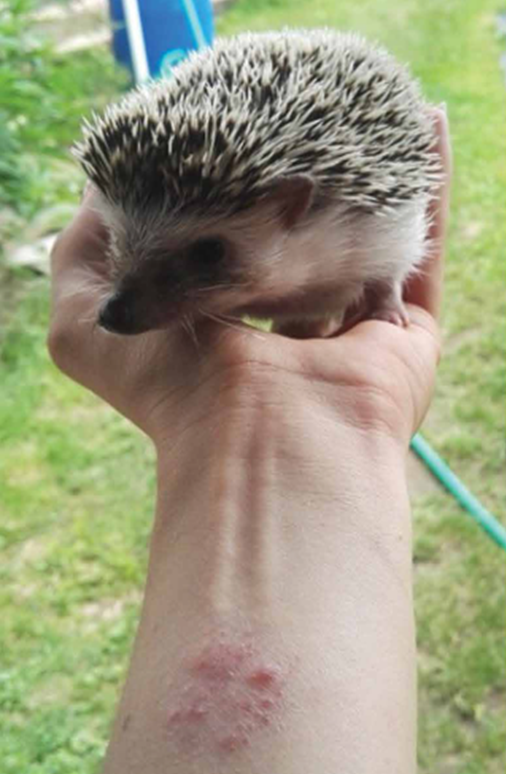Fungal pathogens of humans and animals
We focus on a comprehensive understanding of fungi causing diseases in humans and animals. Our research targets “emerging diseases,” which are newly appearing or rapidly spreading within populations. We study dermatophytes, the genus Aspergillus, Candida, Pseudogymnoscus destructans (the cause of White Nose Syndrome in bats), and other groups. Dermatophytes (Ascomycota, Onygenales) cause various skin diseases, including infections of the hair and nails. The first step in identifying new diseases is to determine the spectrum of existing species, which involves studying epidemiology. Our epidemiological studies are conducted in collaboration with numerous clinical and veterinary institutions in the Czechia and worldwide. Through these studies, we have discovered an increase in the occurrence of several dermatophyte species, such as Trichophyton benhamiae transmitted by guinea pigs, T. erinacei transmitted by hedgehogs, and T. quinckeanum transmitted by dogs and cats. Population genetic analysis of these species and the T. mentagrophytes complex has enabled us to distinguish cryptic species and trace their migration paths. Our research has led to the description of many new species, such as Auxarthron ostraviense, Trichophyton europeum, T. japonicum, T. onychocola, and T. spiraliforme. We are also improving diagnostic procedures and communicating with the medical community. We study wild mammals, particularly rodents and hedgehogs, to determine if they are reservoirs of previously unknown dermatophytes, potential new human pathogens. We investigate the secondary metabolites of dermatophytes, including volatile compounds, to see if they play a role in virulence or can be used in diagnostics. For new pathogens, we seek to identify the virulence factors responsible for their successful spread. Additionally, we monitor the occurrence of drug resistance in dermatophytes, Aspergillus fumigatus, and Candida spp.

The main results are summarized in the following works, which also highlight the extent of our international collaboration.
- Hubka V, Čmoková A, Peano A, Větrovský T, Dobiáš R, Mallátová N, Lysková P, Mencl K, Janouškovcová H, Stará J, Kuklová I, Doležalová J, Hamal P, Svobodová L, Koubková J, Kolařík M (2018) Zoonotické dermatofytózy: klinický obraz, diagnostika, etiologie, léčba, epidemiologická situace u nás. Československá Dermatologie 93: 205–292.
- Lysková P, Dobiáš R, Kuklová I, Mallátová N, Čmoková A, Kolařík M, Vojtíšková V, Karpetová L, Hubka V (2018) Pět případů lidských dermatofytóz vyvolaných zoofilním druhem Trichophyton erinacei přeneseným z ježků. Československá Dermatologie 93: 237-243.
- Lysková P, Skruzná M, Kubánek M, Kautznerová D, Hosková L, Vrbská J, Zácková P, Dobias R, Jaworská P, Mrázek J, Kolarík M, Sumerauerová P, Nemcová D, Hubka V (2019) Cryptic Aspergillus species – A case report of chronic cavitary pulmonary Aspergillus lentulus infection in a heart transplant recipient. Klinicka Mikrobiologie a Infekcni Lekarstvi 25: 48-52
- Veselská T, Homutová K, Fraile PG, Kubátová A, Martínková N, Pikula J, Kolařík M (2020) Comparative eco-physiology revealed extensive enzymatic curtailment, lipases production and strong conidial resilience of the bat pathogenic fungus Pseudogymnoascus destructans. Scientific reports 10: 1-13.
- Řeulka J, Kolařík M, Hubka V (2020) Clinical and histopathological changes in rainbow trout Oncorhynchus mykiss experimentally infected with fungus Bradymyces oncorhynchi. Folia Microbiologica 65, 1025–1032
- Čmoková A, Kolařík M, Dobiáš R, Hoyer LL, Janouškovcová H, Kano R, Kuklová I, Lysková P, Machová L, Maier T, Mallátová N, Man M, Mencl K, Nenoff P, Peano A, Prausová H, Stubbe D, Uhrlaß S, Větrovský T, Wiegand C, Hubka V (2020) Resolving the taxonomy of emerging zoonotic pathogens in the Trichophyton benhamiae complex. Fungal Diversity 104: 333-387
- Čmoková A, Rezaei-Matehkolaei A, Kuklová I, Kolařík M, Shamsizadeh F, Ansari S, Gharaghani M, Miňovská V, Najafzadeh MJ, Nouripour‐Sisakht S (2021) Discovery of new Trichophyton members, T. persicum and T. spiraliforme spp. nov., as a cause of highly inflammatory tinea cases in Iran and Czechia. Microbiology Spectrum 9:e00284-00221
- Lysková P, Dobiáš R, Čmoková A, Kolařík M, Hamal P, Šmatláková K, Hušek J, Mencl K, Mallátová N, Poláčková Z (2021) An outbreak of Trichophyton quinckeanum zoonotic infections in the Czech Republic transmitted from cats and dogs. Journal of Fungi 7: 684.
- Čmoková A, Kolařík M, Guillot J, Risco-Castillo V, Cabañes F, Nenoff P, Uhrlaß S, Dobiáš R, Mallátová N, Yaguchi T. V. Hubka (2022) Host-driven subspeciation in the hedgehog fungus, Trichophyton erinacei, an emerging cause of human dermatophytosis. Persoonia-Molecular Phylogeny and Evolution of Fungi 48:203-218.
- Moulíková Š, Kolařík M, Lorch JM, Kolarczyková D, Hubka V, Čmoková A. (2023) Wild rodents harbour high diversity of Arthroderma. Persoonia-Molecular Phylogeny and Evolution of Fungi 50:27-47.
- Seidlova V, Pikula J, Kolarik M, Nováková A, Cmokova A, Ghazaryan A, Nemcova M, Bednarikova S, Patra S, Kokurewicz T. (2023) Higher white-nose syndrome fungal isolate yields from UV-guided wing biopsies compared with skin swabs and optimal culture media. BMC Veterinary Research 19:1-12.
- Řehulka J, Kubátová A, Hubka V. (2023) A visceral mycosis in farmed rainbow trout (Oncorhynchus mykiss) caused by Neopyrenochaeta submersa. Medical Mycology Case Reports 41: 4-7
- de Hoog S, et al. (2023) A conceptual framework for nomenclatural stability and validity of medically important fungi: a proposed global consensus guideline for fungal name changes supported by ABP, ASM, CLSI, ECMM, ESCMID-EFISG, EUCAST-AFST, FDLC, IDSA, ISHAM, MMSA, and MSGERC. J Clin Microbiol 61:e00873-23.
- Švarcová M, Větrovský T, Kolařík M, Hubka V. (2023) Defining the relationship between phylogeny, clinical manifestation, and phenotype for Trichophyton mentagrophytes/interdigitale complex; a literature review and taxonomic recommendations. Medical Mycology 61:myad042.
- Kolarczyková D, Lysková P, Švarcová M, Kuklová I, Dobiáš R, Mallátová N, Kolařík M, Hubka V (2024) Terbinafine resistance in Trichophyton mentagrophytes and Trichophyton rubrum in the Czech Republic: A prospective multicentric study. Mycoses 67(2):e13708.
- Řehulka J, Hubka V (2024) A renal mycosis of roach (Rutilus rutilus) caused by the Aureobasidium pullulans. Medical Mycology Case Reports 44: 100652